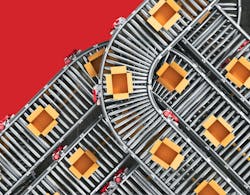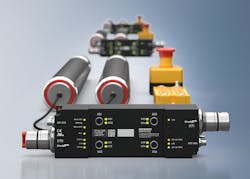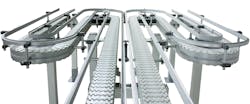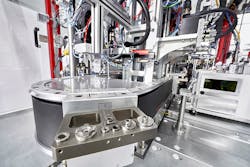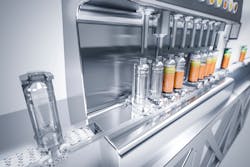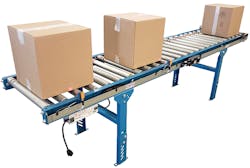Why Conveyance Technologies Remain an Industry Lynchpin
Conveyors are the workhorse of industry. Without them, materials wouldn’t be able to move from point A to point B, product lines would grind to a halt, and industry as we know it would be an impossibility. In fact, conveyors are so ubiquitous that they are often taken for granted, as many consider them a mere rudimentary cog in the production process, rather than a potential canvas for innovation.
However, as Industry 4.0 paves the way for a more networked, digital industrial landscape—including mass customization and just-in-time manufacturing—the demand for increased flexibility in both the intralogistics and manufacturing spaces means that conveyance systems are being looked at with renewed attention.
“In the past, conveyors were usually just an afterthought. People would set up production lines and the conveyors would be added sometime later just to transport materials back and forth,” says Bryant Boyd, senior electrical engineer at Bosch Rexroth. “Now we see people beginning to spec the conveyor system first, and we’re beginning to think of conveyance as being the base for automation. The conveyor can set the line speed, and it can tell your automation system where things should be based on cuing, rotation, and precision.”
According to Richard Canny, president at Ultimation Industries, distributed power and control have been major enablers of this shift. Whereas a single, large motor once drove a chain conveyor carrying many loads, the growing use of smaller motors coupled with variable frequency drives (VFDs) and digital feedback sensors has allowed production lines to be broken into separate zones, each of which starts and stops whenever necessary, allowing for more precise positioning of products, energy efficiency gains, and improved overall equipment effectiveness.
Motor-driven roller conveyors
Known as MDRs (motor driven roller conveyors), these distributed conveyance systems are a tremendous boon in distribution centers, where cases and packages of different sizes frequently move along the same line. By preventing disparate products from ever physically touching, MDRs can prevent back-pressure and the friction that comes with it, reducing wear and tear on equipment and increasing energy efficiency. Not only that, in Ultimation’s case a separate controller can operate without being included in a programmable logic controller’s programming, making deployment and integration less taxing.
In addition, the same feedback mechanisms that allow the varying zones of an MDR to communicate with one another and adjust their speed accordingly can act as portals for digital condition monitoring. With sensors attuned to amperage, temperature, torque, and myriad other performance indicators, the advanced motors and drives built into MDR systems can provide a powerful tool for predictive maintenance.
“What is going on with your conveyance performance from a maintenance perspective? How much amperage is the motor drawing? Are the bearings at an elevated temperature? How many hours of operation does the belt have on it? We use all of this data to provide predictive maintenance information to our customers,” says Mike Hosch, vice president for industrial products at Dorner. “In the past, you either had to wait until equipment failed—which is obviously not what you want to do—or you had to put in some preventative maintenance steps where you might be replacing something that still has life in it. Now, instead of replacing a bearing or belt at 15,000 hours when it could have gone 18,000, we replace it at 17,500 and gain more production life.”
And while MDRs have been predominantly deployed in the intralogistics space, Hosch foresees their eventual adoption in large assembly operations as well, particularly as their payload capacity improves.
Flexible technologies
Industry’s general drive for ever-greater flexibility has also led to the development of more nimble conveyance systems. For instance, B&R Industrial Automation’s AcoposTrak utilizes independently controlled shuttles to transport products between processing stations. Its design is particularly well-suited to the increasing demand for mass customization currently sweeping over the market for consumer goods. By employing a series of looped tracks, AcoposTrak is able to diverge and merge individual products into small, customized batches. For example, a customer who placed an online order could be provided with a six-pack of sodas featuring a flavor combination of their choosing.
“You could automate meal kit production so that each shuttle was programmed to produce a customized meal. So, you wouldn’t just have to say, ‘I have peas, carrots, mashed potatoes, and meatloaf.’ Instead, you could say, ‘I want three slices of meat loaf instead of two, mashed potatoes with double gravy, no peas, and double carrots,” says John Kowal, marketing director at B&R Industrial Automation. “The consumer could actually order that online, and it could be delivered directly from the production line.”
According to Kowal, meeting the demand for customization should be a priority for manufacturers because, if they don’t, someone else will.
Beyond customization applications, other conveyance benefits of AcoposTrak include easing small batch production. Its set of looped tracks allow for parallel processing, meaning that multiple stations can perform the same process concurrently. If a piece of equipment—such as a bottle filler head—breaks down, remaining products can be redirected through a different route without ceasing production.
Another added benefit is that AcoposTrak can shrink a conveyance system’s footprint. Not only is space saved when fewer make-to-stock products are kept on hand, but the conveyor itself is smaller due to its reduced need for buffering, accumulation, and queuing of goods. With floor space often at a premium, the shrinkage is significant. Kowal estimates that AcoposTrak can decrease the space required for product transport by up to 50%.
Modular conveyance systems are also becoming an increasingly popular product from automation technology providers. Bosch Rexroth, for example, offers its conveyors in configurable segments that can be flexibly assembled to accommodate a plant’s unique needs upon initial installation and reduce changeover times during any subsequent reconfigurations.
CAD software and digital twin simulations have proven essential in such applications. Through software like Bosch Rexroth’s MTpro, conveyance layouts can be digitally prototyped prior to actual setup, allowing for less risk and far more accurate planning. And while end users can certainly benefit in that regard, machine builders looking to prove the viability of innovative new designs stand to gain as well.
“Very often, machine builders with a new design have to invest in a prototype machine to bring to a trade show. It’s all speculative, and they don’t know if they’re going to be able to sell it or even if it’s going to work,” Kowal says. “With a simulation, they’re going to know it’s going to work before they spend any money; and a lot of machine builders are smaller companies, so they can’t afford to make any mistakes. In addition to helping end users and manufacturers plan ahead, this is going to help machine builders innovate by removing risk. It’s a win-win.”
The importance of integration
As conveyance continues to grow more flexible, adaptive, and intelligent, integration with other automation technologies will rise to the forefront, says Matt Prellwitz, motion control product manager at Beckhoff USA. With many robotics technologies requiring the use of a conveyor, the capacity for highly precise positioning, as well as the ability to communicate and synchronize with other devices, will be paramount.
In situations where six-axis robotic arms are employed, a conveyor may actually come to represent a seventh axis. For instance, both B&R and Bosch Rexroth offer conveyors capable of positioning products within microns of accuracy to coordinate their alignment with the motion of a robotic arm. In automobile manufacturing too, large component parts with complex three-dimensional shapes can prove difficult to manipulate without the assistance of crowders and stabilizers which must be able to coordinate with conveyors.
According to Kowal, companies that can offer conveyance systems, robotics, and machine vision sensors as a holistic package may be positioned to win big by eliminating the complexities that accompany communication between products from various vendors.
Canney suggests that the shift toward distributed power and control occurring in conveyance systems could mirror the transformation of the overall industry landscape. Whereas large centralized facilities were once the lynchpin of effective operations, he sees them being supplanted by a digitally optimized web of smaller factories and distribution centers making use of faster, more modular technologies.
“We look ahead and see a world where humans, robots, and conveyors will work closely together in the same physical space,” Canney says. “We believe that, in the next decade, the entire supply chain will be automated—and that’s going to include conveyance, robotics, automated loading and unloading, transport systems, and even autonomous electric vehicles. Advanced conveyors are going to be a big part of enabling this, so we truly see these technologies moving together in synergy.”
About the Author
David Miller
Former Senior Technical Writer

Leaders relevant to this article:
